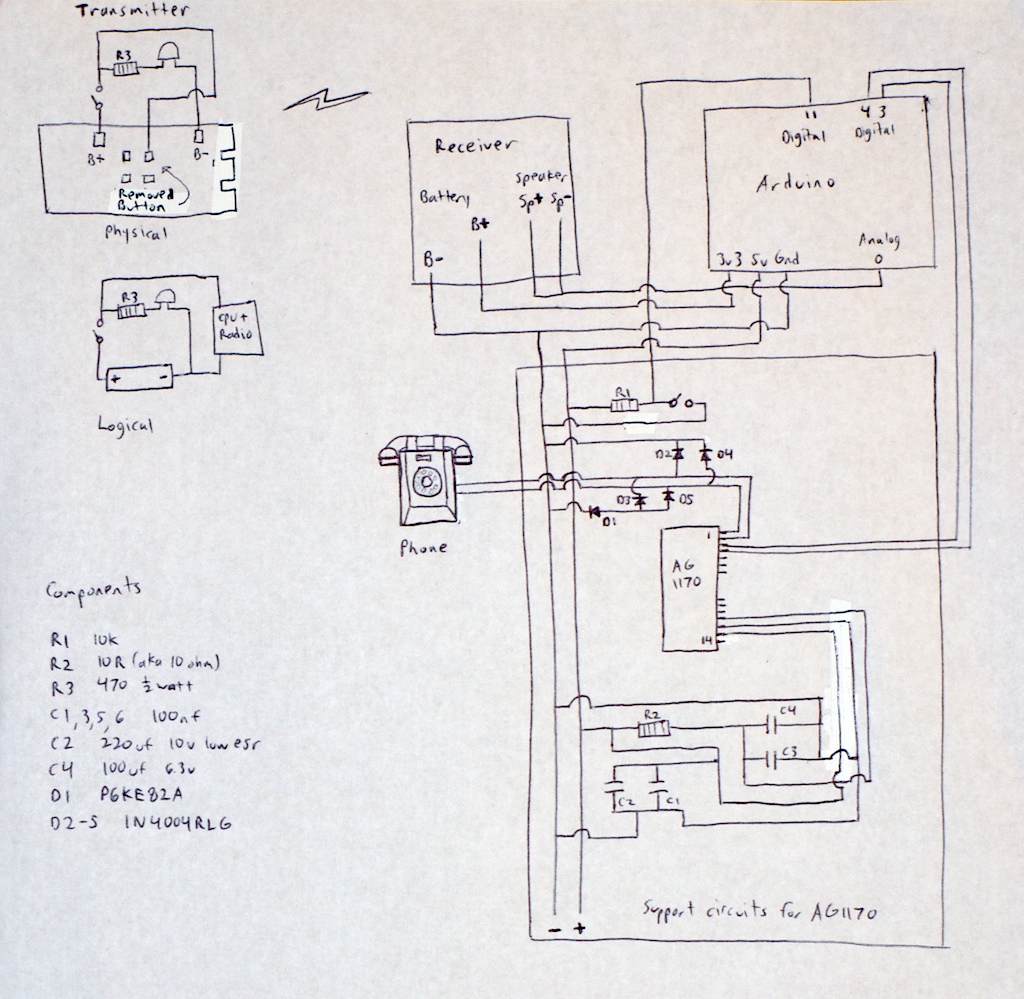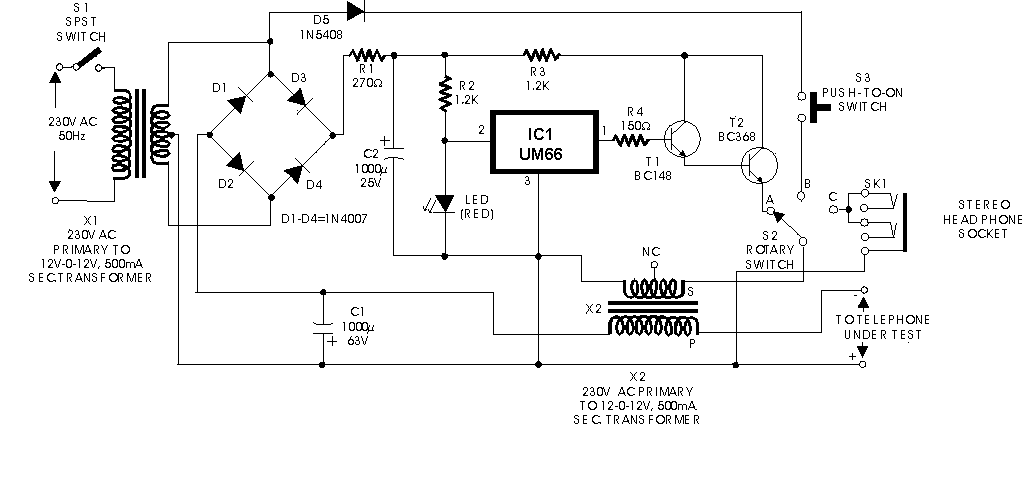
Doorbell Phone

Any phone can be utilized for this project, so there is no need to worry about obtaining the same model as mentioned. If an antique Bakelite phone is chosen, basic restoration steps include cleaning it with a rag dampened in environmentally friendly orange-based cleaners. However, if the Bakelite is heavily worn, cracked, or sun-bleached, restoration is nearly impossible. If the Bakelite appears dull after cleaning, polishing with black shoe polish may be an option. As a last resort, some individuals paint it black, although this may not be well-received by antique enthusiasts. Touching up chipped painted numbers on the dial can be done with a toothpick and white model paint. The chrome or nickel on the dial can be cleaned with a generic metal polish, but caution is advised to avoid removing the plating. Inside the DE 200, there is a large capacitor (labeled condenser) that may need replacement due to deterioration over time, which can result in weak ringing. An equivalent modern capacitor can be sourced if a schematic is available, or the capacitor can be bypassed by connecting the incoming wires directly to the ringer coils. Replacing the wall cord involves disconnecting the old one and connecting a new one. If a plunger is missing, a metal collar and rivet can serve as a replacement. As long as the ringer functions, other electrical issues can be overlooked. The project may evolve to utilize the dial and handset in future versions. If the receiver electronics are integrated into the phone, it should be positioned near a power outlet. Alternatively, if placed in an external box, that box will also need to be near a power outlet, while the phone can be positioned within reach of a phone cord. For aesthetic purposes, the external box should be hidden away. For renters, creative mounting solutions may be necessary, such as using strong Velcro on a cabinet or shelf. Caution is advised with adhesive backing, as removal may damage surfaces. An alternative method involves using a bolt from a cabinet to secure the phone with a zip tie.
The project encompasses the restoration and modification of a Bakelite phone, which involves both aesthetic and functional considerations. The initial step is to clean the phone using eco-friendly cleaning agents, ensuring that any dirt or grime is removed without damaging the material. The condition of the Bakelite is critical; if it is excessively damaged or faded, restoration may not be feasible. For minor imperfections, polishing techniques can be applied, but care must be taken to maintain the integrity of the original surface.
When addressing internal components, particularly the capacitor, it is essential to understand its role in the phone's operation. A failing capacitor can affect the phone's ringing mechanism, necessitating either replacement or bypassing. If opting for a bypass, it is crucial to ensure that the connections are secure to avoid any potential short circuits. The wall cord replacement should be executed with attention to detail, ensuring that the new cord is adequately stripped and connected to prevent any electrical failures.
For any missing mechanical parts, improvisation with hardware store components can yield satisfactory results. The focus should remain on ensuring that the ringer operates correctly, as this is the primary function required for the current project iteration. Future enhancements may include integrating the dial and handset, which would require additional electronic components and careful planning regarding power supply and wiring.
When considering placement, the project requires strategic thinking, especially in rental situations where drilling is not an option. Utilizing existing furniture or structures for mounting can mitigate potential damage to property while providing a functional and aesthetically pleasing installation. The use of Velcro or zip ties for secure mounting offers flexibility and ease of removal should the need arise in the future. Overall, the project emphasizes a blend of restoration, modification, and practical application, ensuring that the Bakelite phone serves its purpose while retaining its vintage charm.You could really use any phone for this project, so don`t worry if you can`t get or don`t want the same model as mine. If you do get an antique bakelite phone, here are some basic steps for restoration. Clean your phone with a rag dampened in one of those environmentally friendly orange based cleaners. If the bakelite is heavily worn, cracked, or sun bleached, you`re out of luck. It`s pretty much impossible to restore bakelite in that condition. Trust me. If your bakelite is dull after cleaning, you might be able to get away with polishing it with black shoe polish. As a last resort some people paint it black (I see a red door), but antique snobs will have a coronary at the mere mention of this.
I say if it`s your last resort and you`re not trying to resell the phone as mint condition , go for it. Here`s a good site on bakelite restoration. The painted numbers on my dial were chipping badly so I used a toothpick and some white Testors model paint to touch them up a little.
The black paint on the dial was worn just enough to look good but not ratty so I left it the way it was. The chrome (or nickel) on the dial was tarnished so I cleaned it with some generic metal polish that was white and smelled like ammonia.
Don`t rub too hard or you might take off the plating, exposing the yellow metal underneath. In the the DE 200 there`s a giant capacitor (labeled condenser ) inside. Capacitors go bad over the years and need to be replaced, and mine was causing the phone to ring weakly. You can try to find an equivalent modern capacitor if you have a schematic for the phone, or go the route I did and just bypass it.
Connect the two incoming wires from the wall directly to the coils on the ringer by either soldering them or using alligator clips. I replaced the wall cord with a newer and longer one, nothing special, just disconnect the old one, strip the end of the new one, and screw in the wires where the old ones were.
One of the plungers (the metal posts that pop up from under the handset when you pick it up) was missing so I found a metal collar and rivet at my local hardware store and improvised a fairly close replacement. You can see them sitting on top of the cabinet in the picture below. As long as the ringer works you can ignore any other electrical problems with the phone, we don`t need to use the dial or handset.
It`s possible that in a future version of this project we would want to use them because the phone interface board (more on that later) has the capability, but for now we`re keeping it simple. As I mentioned a while back, if you`re able to fit all the receiver electronics inside the phone it will need to be mounted near a power outlet.
If you put the electronics in an external box the box will need to be near a power outlet, while the phone can then be anywhere within reach of a phone cord connecting the two. If you have an ugly box you`ll want a location out of the way so you can hide it in a cabinet or behind something.
Do you like this project or have suggestions on how to make it better Do you want me to build one for you Do you need tutoring on Arduinos, programming, and basic electronics If you`re using a wall phone and you`re a renter like me, you need to get creative. Your landlord probably won`t appreciate you drilling holes in her walls so you can mount the phone like a normal human being.
Instead, try mounting it on the side of some shelves, cabinet, or other vertical surface you own. You could get some strong velcro with a glue backing from your local hardware store and mount the phone to the cabinet. The only problem is that if you get tired of the phone you`ll probably have trouble removing the velcro from the cabinet thanks to the glue.
I got lucky and found that my cabinet was held together with bolts going from the top down into the sides. I loosened one so that it stuck up about 1/4 inch from the surface and threaded a zip tie around it 🔗 External reference
The project encompasses the restoration and modification of a Bakelite phone, which involves both aesthetic and functional considerations. The initial step is to clean the phone using eco-friendly cleaning agents, ensuring that any dirt or grime is removed without damaging the material. The condition of the Bakelite is critical; if it is excessively damaged or faded, restoration may not be feasible. For minor imperfections, polishing techniques can be applied, but care must be taken to maintain the integrity of the original surface.
When addressing internal components, particularly the capacitor, it is essential to understand its role in the phone's operation. A failing capacitor can affect the phone's ringing mechanism, necessitating either replacement or bypassing. If opting for a bypass, it is crucial to ensure that the connections are secure to avoid any potential short circuits. The wall cord replacement should be executed with attention to detail, ensuring that the new cord is adequately stripped and connected to prevent any electrical failures.
For any missing mechanical parts, improvisation with hardware store components can yield satisfactory results. The focus should remain on ensuring that the ringer operates correctly, as this is the primary function required for the current project iteration. Future enhancements may include integrating the dial and handset, which would require additional electronic components and careful planning regarding power supply and wiring.
When considering placement, the project requires strategic thinking, especially in rental situations where drilling is not an option. Utilizing existing furniture or structures for mounting can mitigate potential damage to property while providing a functional and aesthetically pleasing installation. The use of Velcro or zip ties for secure mounting offers flexibility and ease of removal should the need arise in the future. Overall, the project emphasizes a blend of restoration, modification, and practical application, ensuring that the Bakelite phone serves its purpose while retaining its vintage charm.You could really use any phone for this project, so don`t worry if you can`t get or don`t want the same model as mine. If you do get an antique bakelite phone, here are some basic steps for restoration. Clean your phone with a rag dampened in one of those environmentally friendly orange based cleaners. If the bakelite is heavily worn, cracked, or sun bleached, you`re out of luck. It`s pretty much impossible to restore bakelite in that condition. Trust me. If your bakelite is dull after cleaning, you might be able to get away with polishing it with black shoe polish. As a last resort some people paint it black (I see a red door), but antique snobs will have a coronary at the mere mention of this.
I say if it`s your last resort and you`re not trying to resell the phone as mint condition , go for it. Here`s a good site on bakelite restoration. The painted numbers on my dial were chipping badly so I used a toothpick and some white Testors model paint to touch them up a little.
The black paint on the dial was worn just enough to look good but not ratty so I left it the way it was. The chrome (or nickel) on the dial was tarnished so I cleaned it with some generic metal polish that was white and smelled like ammonia.
Don`t rub too hard or you might take off the plating, exposing the yellow metal underneath. In the the DE 200 there`s a giant capacitor (labeled condenser ) inside. Capacitors go bad over the years and need to be replaced, and mine was causing the phone to ring weakly. You can try to find an equivalent modern capacitor if you have a schematic for the phone, or go the route I did and just bypass it.
Connect the two incoming wires from the wall directly to the coils on the ringer by either soldering them or using alligator clips. I replaced the wall cord with a newer and longer one, nothing special, just disconnect the old one, strip the end of the new one, and screw in the wires where the old ones were.
One of the plungers (the metal posts that pop up from under the handset when you pick it up) was missing so I found a metal collar and rivet at my local hardware store and improvised a fairly close replacement. You can see them sitting on top of the cabinet in the picture below. As long as the ringer works you can ignore any other electrical problems with the phone, we don`t need to use the dial or handset.
It`s possible that in a future version of this project we would want to use them because the phone interface board (more on that later) has the capability, but for now we`re keeping it simple. As I mentioned a while back, if you`re able to fit all the receiver electronics inside the phone it will need to be mounted near a power outlet.
If you put the electronics in an external box the box will need to be near a power outlet, while the phone can then be anywhere within reach of a phone cord connecting the two. If you have an ugly box you`ll want a location out of the way so you can hide it in a cabinet or behind something.
Do you like this project or have suggestions on how to make it better Do you want me to build one for you Do you need tutoring on Arduinos, programming, and basic electronics If you`re using a wall phone and you`re a renter like me, you need to get creative. Your landlord probably won`t appreciate you drilling holes in her walls so you can mount the phone like a normal human being.
Instead, try mounting it on the side of some shelves, cabinet, or other vertical surface you own. You could get some strong velcro with a glue backing from your local hardware store and mount the phone to the cabinet. The only problem is that if you get tired of the phone you`ll probably have trouble removing the velcro from the cabinet thanks to the glue.
I got lucky and found that my cabinet was held together with bolts going from the top down into the sides. I loosened one so that it stuck up about 1/4 inch from the surface and threaded a zip tie around it 🔗 External reference





